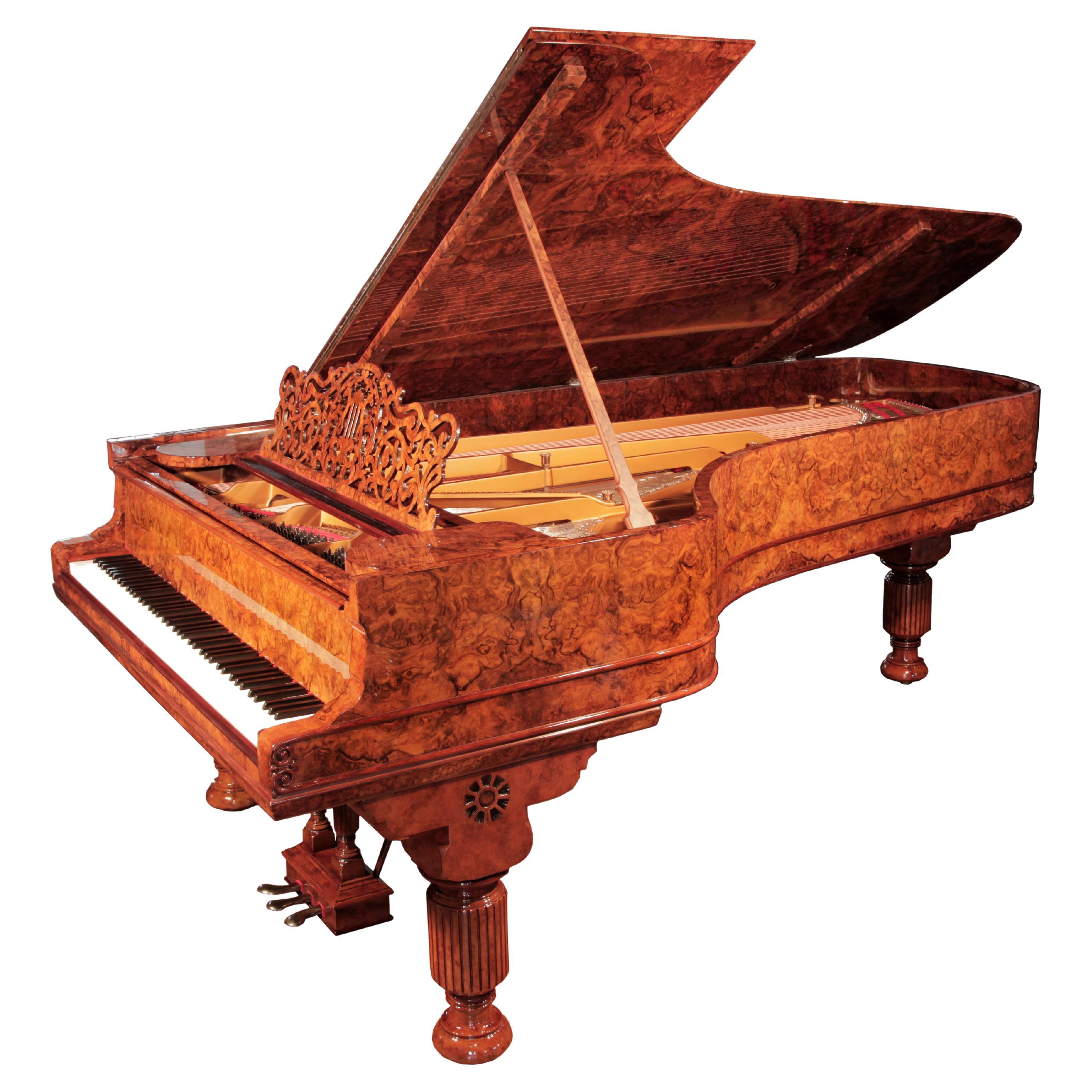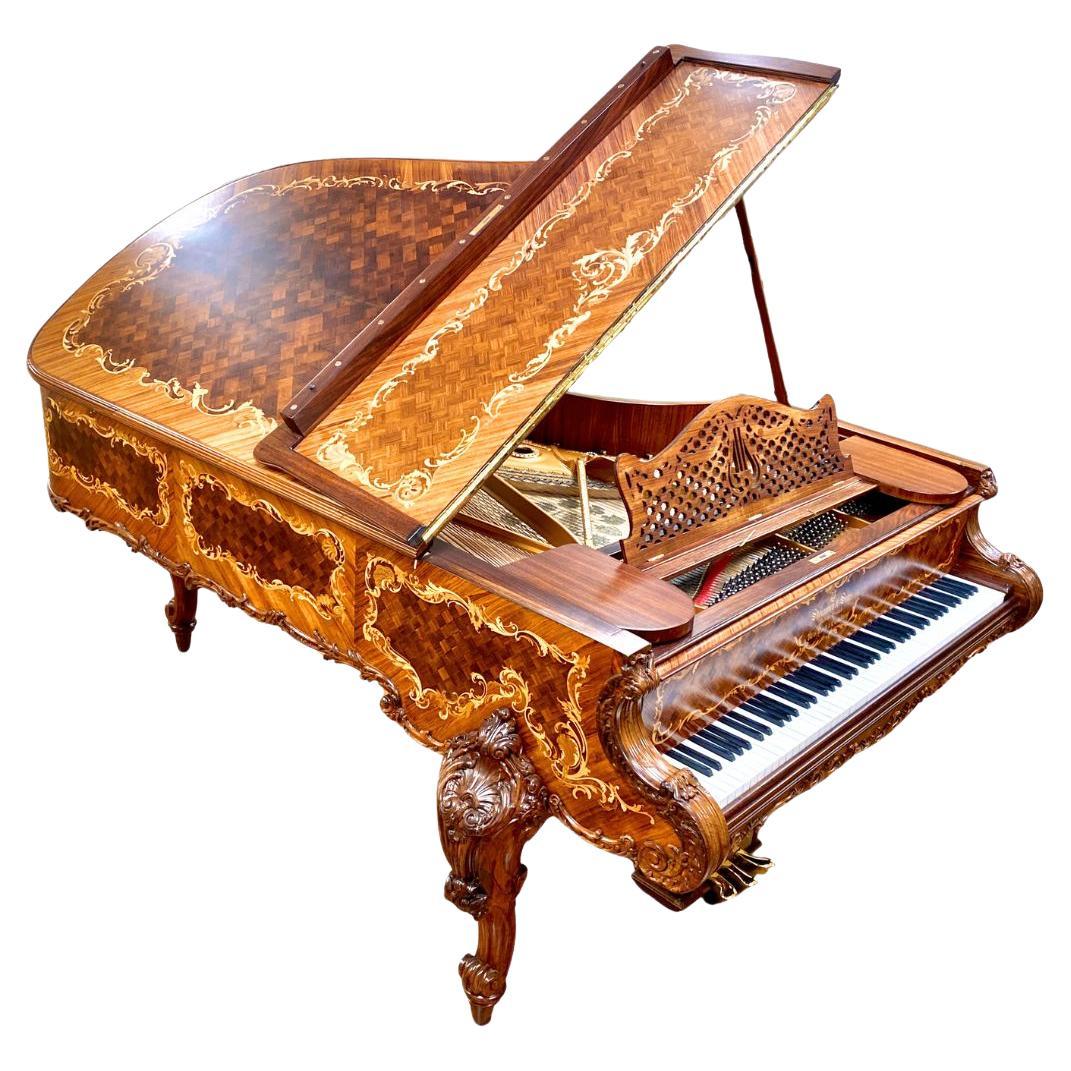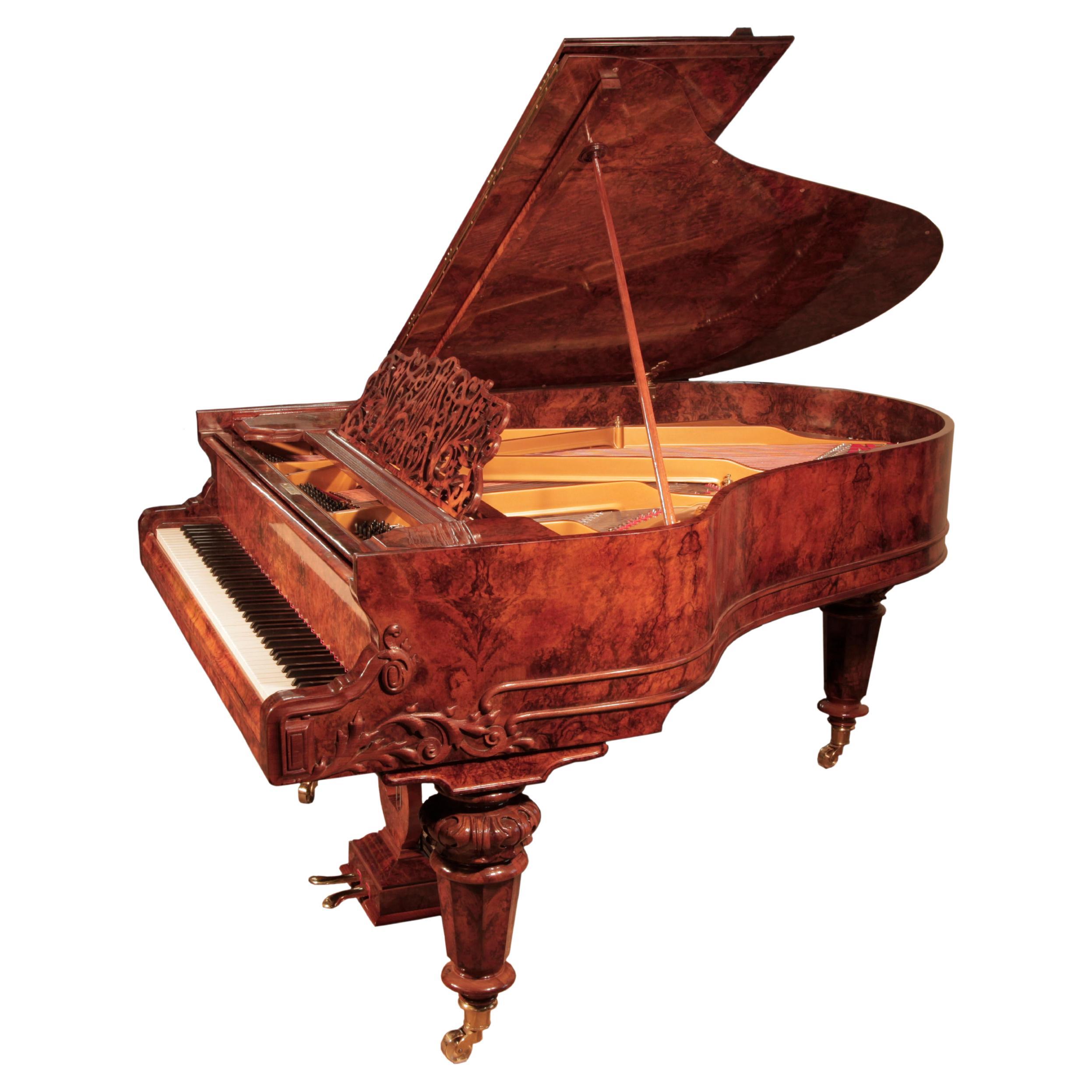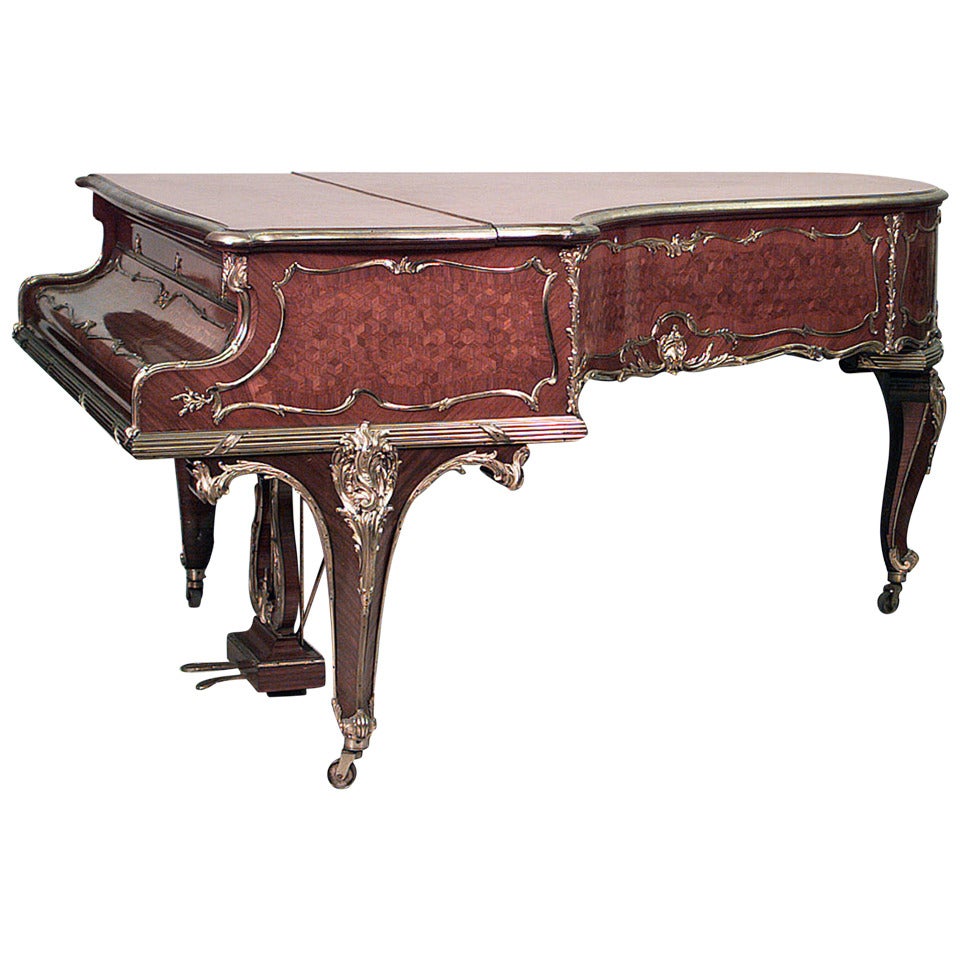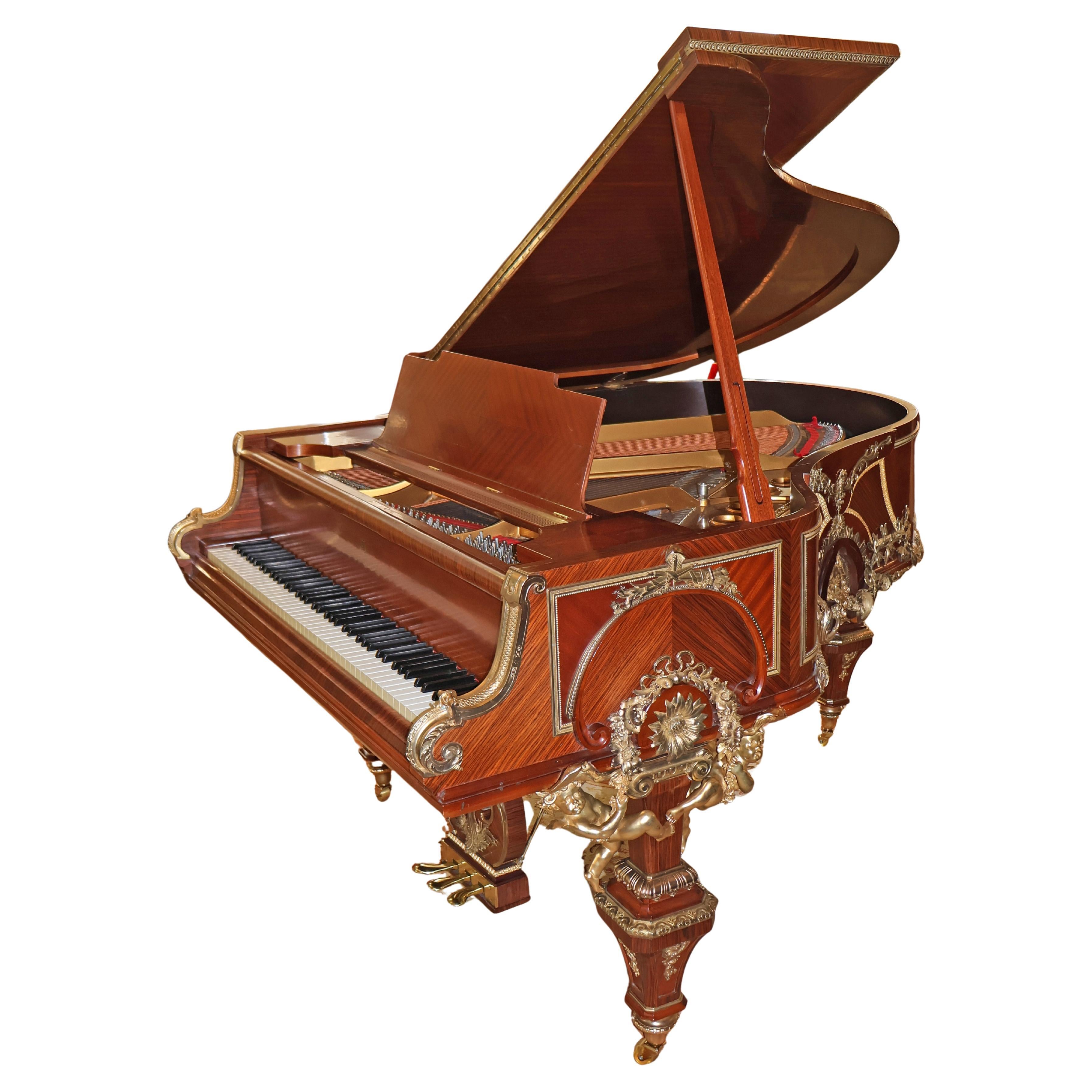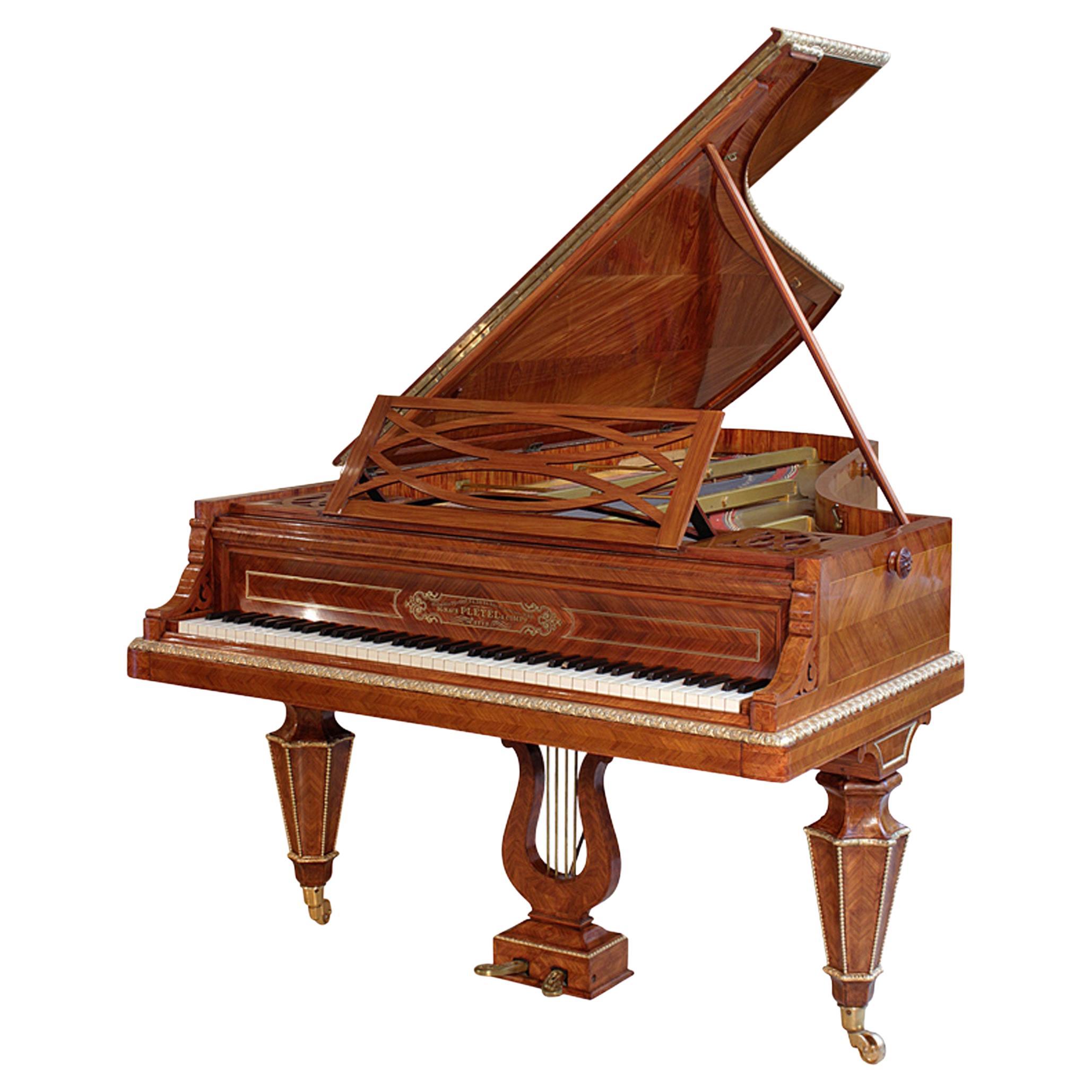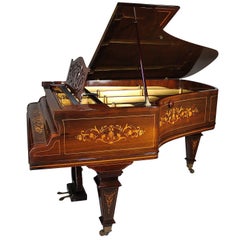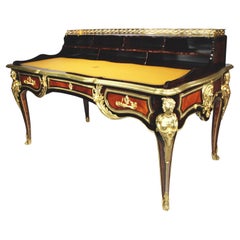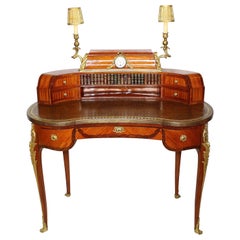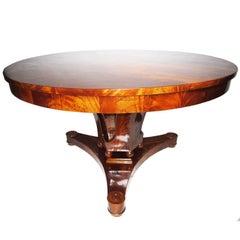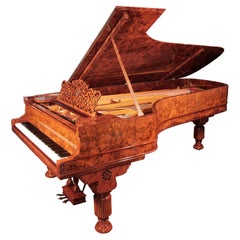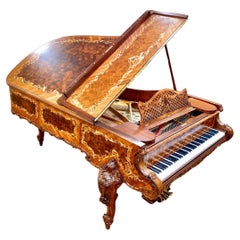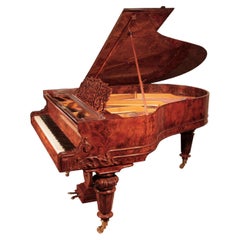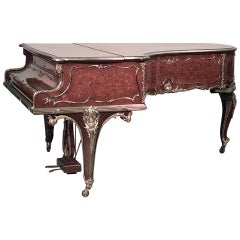Items Similar to A German 19th Century Louis XVI Style Burr Walnut Bechstein Concert Grand Piano
Video Loading
Want more images or videos?
Request additional images or videos from the seller
1 of 20
A German 19th Century Louis XVI Style Burr Walnut Bechstein Concert Grand Piano
$49,850
$74,85033% Off
£37,642.14
£56,519.8433% Off
€43,397.76
€65,161.9433% Off
CA$70,359.54
CA$105,645.1633% Off
A$77,557.95
A$116,453.6133% Off
CHF 40,582.01
CHF 60,934.0733% Off
MX$951,611.77
MX$1,428,849.3733% Off
NOK 510,847.10
NOK 767,039.2233% Off
SEK 477,722.82
SEK 717,302.9733% Off
DKK 323,951.32
DKK 486,414.3733% Off
About the Item
A Very Fine German 19th Century Louis XVI Style Burr Walnut Bechstein Concert Grand Piano, Serial No. 5655. The beautifully crafted Grand piano, raised on three tapered barrel shaped legs, with an intricately carved ornate music desk and original keys. Circa: 1872.
Length: 80 inches (203.2 cm)
Width: 59 inches: (149.9 cm)
Height (top closed): 38 5/8 inches (98.1 cm)
C. Bechstein Pianofortefabrik
C. Bechstein Pianofortefabrik AG (also known as Bechstein) is a German manufacturer of pianos, established in 1853 by Carl Bechstein.
Before Bechstein
Young Carl Bechstein studied and worked in France and England as a piano craftsman, before he became an independent piano maker. His first pianos were made for other companies.
C. Bechstein
C. Bechstein piano factory was founded on 1 October 1853 by Carl Bechstein in Berlin, Germany.
Carl Bechstein set out to manufacture a piano able to withstand the great demands imposed on the instrument by the virtuosi of the time, such as Franz Liszt. In 1857, Hans von Bülow (Liszt's son-in-law) gave the first public performance on a Bechstein grand piano by performing Liszt's Piano Sonata in B minor in Berlin
By 1870, with endorsements from Franz Liszt and Hans von Bülow, Bechstein pianos had become a staple in many concert halls and private mansions. By that time three piano makers, all of which were founded in 1853, became established as the industry leaders across the world: Bechstein, Blüthner and Steinway & Sons.
In 1881 Bechstein began supplying pianos to Queen Victoria. A gilded art-case piano was delivered to Buckingham Palace, followed by several more Bechstein pianos to Windsor Castle and other royal residences. By January 1886 they were among the piano manufacturers holding a Royal Warrant as a supplier to the Queen. Several British embassies across the world acquired Bechstein pianos.
In 1885, Bechstein opened a branch in London, that eventually grew to become the largest showroom and dealership in Europe. By 1890 showrooms had been opened in Paris, Vienna, and Saint Petersburg. On 31 May 1901, Bechstein Hall, built at a cost of £100,000, was opened next to the company's London showroom at 36-40 Wigmore Street. Between 1901 and 1914, C. Bechstein was the largest piano dealership in London. At that time, Bechstein was patronized by the tsars of Russia, the royal families of Spain, Belgium, the Netherlands, Italy, Sweden, Norway, Austria and Denmark, and other royalty and aristocracy. The list of royal clients of Bechstein may be found on the soundboard of vintage Bechstein pianos made before the Second World War. The list is part of the original Bechstein trademark logo; it can be seen under the strings in the center of a piano's soundboard.
The signature of Carl Bechstein
The years from the 1870s through 1914 brought Bechstein their most dramatic increase in sales. In 1880 a second Bechstein factory was opened in Berlin, and the third factory was opened in 1897 in Berlin-Kreuzberg. Production reached 3,700 pianos annually in 1900, and 4,600 in 1910, making Bechstein the largest German manufacturer of high-end pianos. At that time, about three quarters of production went to international markets, especially Britain and the Commonwealth, and Russia.
Carl Bechstein died in 1900, and the Bechstein company continued to operate under the management of his sons.
Between 1900 and 1914 C. Bechstein was one of the leading piano makers in the world, employing 1,200 craftsmen and workers by 1913 and making five thousand pianos per year.
First World War
C. Bechstein suffered huge property losses in London, Paris, and St. Petersburg during World War I. The largest loss was in London. Although the company's position in the United Kingdom was initially unaffected, with the company still listed as holding a Royal Warrant in January 1915, Warrants to both King George V, and his wife Queen Mary were cancelled on 13 April 1915. Bechstein was not the only musical concern to be affected by growing anti-German sentiment: there were earlier attempts, led by William Boosey, to boycott German music altogether. In 1915, despite being a Baronet and Privy Counsellor, Sir Edgar Speyer, who was then funding the Proms, was forced to leave the country. Following the passing of the Trading with the Enemy Amendment Act 1916 the British arm of the company was wound-up on 5 June 1916, all Bechstein property, including the concert hall and showrooms full of pianos, were seized as "enemy property" and closed. In 1916 the hall was sold as alien property at auction to Debenhams for £56,500. It was renamed Wigmore Hall, and then re-opened under the new name in 1917. All 137 Bechstein pianos at the Bechstein showrooms were confiscated too, and became property of the new owner of the Hall. After a dispute with his brother, Edwin Bechstein left the company and was paid off.
Eventually the Bechstein factory resumed full-scale production during the 1920s. At that time, technical innovations and inventions of new materials and tools, as well as improvements in piano design and construction, had allowed Bechstein to become one of the leading piano makers again.
The most successful models were the updated "A"-185 and "B"-208 grand pianos. The upright pianos became more popular after the war, and C. Bechstein were successful with its upright pianos Model-8 and Model-9, both of which have been considered the finest upright pianos.
As the company was changed into a joint-stock company 1923, Edwin Bechstein and his wife Helene, bought themselves back into the company as shareholders.
In 1930 the company collaborated with German electrical goods manufacturer Siemens under Nobel laureate Walther Nernst to produce one of the first electric pianos, the "Neo-Bechstein" or "Siemens-Bechstein" electric grand, using electromagnetic pickups.
Edwin Bechstein and his wife, Helene Bechstein, who was an ardent admirer of the Nazi leader Adolf Hitler, bestowed many gifts on Hitler including his first luxury car, a red Mercedes costing 26,000 marks. Helene Bechstein and her friend Elsa Bruckmann introduced Hitler to Germany’s cultural elite in Berlin and Munich. "I wish he were my son," she said.
After Edwin Bechstein died in 1934 in Berchtesgaden, where he had a villa named "Bechstein" in a short distance to the Obersalzberg, his body was transferred to Berlin. He was buried following a state funeral attended by Adolf Hitler and NSDAP politicians, including Wilhelm Frick and Max Amann.
Second World War
In 1945, allied bombing raids destroyed the Bechstein piano factory in Berlin, along with the firm's stores of valuable wood, including the precious Alpine spruce used to make soundboards. The war also cost the company many of its experienced craftsmen. For several years after the war, Bechstein could not resume full-scale production of pianos and made only a few pianos per year.
After World War II
After de-Nazification of the C.Bechstein Company, they started in 1948 to produce pianos again. C. Bechstein eventually increased piano production to about a thousand pianos per year during the 1950s and 1960s. However, the new economic situation in the post-war world was hard for the piano business. In 1961 the Bechstein piano factory was affected by the construction of the Berlin Wall. The ownership of C. Bechstein had changed several times. In 1963 all the shares were sold to the Baldwin Piano Company. Up until the reunification of Germany, the company was making fewer pianos, although the quality of craftsmanship remained high.
In 1953, the centennial of Bechstein was celebrated by the Berlin Philharmonic under Wilhelm Furtwängler and Wilhelm Backhaus. Many entertainers and concert pianists, such as Leonard Bernstein, Jorge Bolet, and Wilhelm Kempff, favored Bechstein pianos. The State Ministry of Culture of the Soviet Union made a contract to supply major state philharmonic orchestras and concert halls across the USSR with three brands of pianos - Steinway & Sons, Blüthner, and Bechstein. Blüthner and Bechstein were also made the staple practice pianos at the Leningrad Conservatory and Moscow Conservatory, while most other music schools of the USSR were limited mainly to the Soviet-made pianos. Concert pianists, such as Dinu Lipatti, Shura Cherkassky, Tatiana Nikolayeva, Vladimir Sofronitsky, and Sviatoslav Richter, among others, often chose Bechstein pianos for their studio recordings.
After the fall of the Berlin Wall
In 1986, Karl Schulze, German entrepreneur and master piano maker, bought Bechstein and continued the legacy of fine piano making. Due to reunification of Germany and elimination of the Berlin Wall, the land formerly belonging to the Bechstein factory was used for new construction in the capital. In 1992 Bechstein started a new factory in Saxony for C. Bechstein and Zimmermann instruments. With investment of 15 million Euros this manufacturing site has become one of the world's most state-of-the-art factories for premium class instruments. Visitor groups are welcome. The manufacturing of Zimmermann instruments in Seifhennersdorf discontinued at the end of 2011.
In 1996, C. Bechstein went public. In 2003, Bechstein formed a partnership with Samick, in order to improve overseas distribution. Today, after the successful capital increase in 2009, Samick no longer has any shares. Nowadays major shareholders are Arnold Kuthe Beteiligungs GmbH as well as Karl Schulze and his wife Berenice Küpper, all Berlin investors.
By 2006, the company opened eight upscale showrooms and increased the number of Bechstein dealerships in major cities across Europe, North America and Asia. New Bechstein center were opened in recent years in New York, Moscow, Shanghai as well as partner centers in Kiev, Seoul, Sydney, and the Netherlands.
In 2007, the new C. Bechstein Europe factory was opened in Hradec Králové, Czech Republic. Bechstein has invested millions of Euros to build up a new, state-of-the-art manufacturing site especially for W. Hoffmann instruments. All brands and instruments made by C. Bechstein now exclusively originate from Europe.
Along with the company's economic success, C. Bechstein's concert grand pianos are making their comeback on international concert stages and in recording studios.
In 2006, the first international C. Bechstein Piano Competition took place under Vladimir Ashkenazy's patronage. National C. Bechstein competitions regularly foster the musical development of young artists.
Artcase pianos
Bechstein has been known as a maker of one-of-a-kind artcase pianos since the 19th century. Artcase pianos were commissioned by interior designers for royal palaces and fancy mansions. Artists and craftsmen were hired by C. Bechstein to make special pianos decorated with gold, hand-carved details, and hand-painted art on the piano case. Some of the artcase Bechsteins are now museum pieces, while others are sometimes traded at musical-instrument auctions, mainly in London and New York.
Performers
Students and followers of Hans von Bülow and Franz Liszt also developed loyalty to Bechstein pianos.
Alexander Scriabin owned a concert-size Bechstein at his Moscow home, which is now a national museum, and Scriabin's piano is still played at scheduled recitals. Tatiana Nikolayeva preferred the Bechstein for her acclaimed recordings of the music of Bach. Sviatoslav Richter grew up studying piano on a Bechstein and remembered his experience with that piano as stimulating and rewarding.
Claude Debussy said "Piano music should only be written for the Bechstein".
Edwin Fischer chose a Bechstein piano for his pioneering recording of Bach's The Well Tempered Clavier, as did Artur Schnabel for his cycle of Beethoven's 32 piano sonatas. Both artists were very fond of Bechstein pianos, as were many of the 20th century's leading pianists, such as Wilhelm Kempff, Wilhelm Backhaus, Walter Gieseking and Jorge Bolet.
Polish pianist Władysław Szpilman (famous thanks to the movie The Pianist) used a Bechstein piano until 1941 in his family private apartments in Warsaw.
For his studio recording of the music of Chopin and Beethoven, Dinu Lipatti used a Bechstein piano.
Bob Dylan played a Bechstein piano at the ABC Theatre in Edinburgh, Scotland on 20 May 1966. He is mentioned on many Bechstein dealers' web pages as a regular Bechstein player.When Dave Stewart of The Eurythmics listed his Bechstein piano for auction, he named Bob Dylan as one of the musicians who had played the piano.
The Bechstein concert grand at London's Trident Studios, over a century old and much sought-after for its sound, became one of the most frequently recorded instruments in rock history. The piano can be heard on The Beatles' "Hey Jude," Elton John's "Your Song," George Harrison's "All Things Must Pass," David Bowie's "Life on Mars?," Lou Reed's "Perfect Day," Queen's "Bohemian Rhapsody," Carly Simon's "You're So Vain," Nilsson's "Without You," and Supertramp's "Crime of the Century." It saw service in the studio from 1968 until the mid 1980s, and has since been sold at auction.
Freddie Mercury of the British rock band Queen played a Bechstein piano on the best-selling album A Night at the Opera. (The liner notes to the album, as reprinted in the 2005 deluxe CD/DVD release of the album, credit Freddie Mercury with "Bechstein Debauchery".)
The music video for Elton John's "Sorry Seems to Be the Hardest Word" features John playing a white Bechstein grand.
Oscar Peterson played and owned a Bechstein throughout much of his career, publicity contracts with rival manufacturers notwithstanding.
Anna Ivanova (2011) played Liszt's personal 1880 Bechstein grand piano, which is displayed in the Liszt Haus in Weimar (Germany). Recordings of her playing both this grand piano, and the Bechstein 576 (which was delivered March 17, 1862 to Franz Liszt), which presently is being displayed at the Bechstein Centre in Berlin, can be found on YouTube.
Awards
In 1862, C. Bechstein was awarded gold medals at the London International Exhibition.
In 2007, C. Bechstein received the iF Gold Award for C. Bechstein Piano Model Millennium.
- Creator:Bechstein Piano Company (Manufacturer)
- Dimensions:Height: 38.63 in (98.13 cm)Width: 80 in (203.2 cm)Depth: 59 in (149.86 cm)
- Style:Louis XVI (In the Style Of)
- Materials and Techniques:
- Place of Origin:
- Period:
- Date of Manufacture:Circa: 1872
- Condition:Repaired: There are some edge ares of the top where there has been some touch ups. Some old stress hairline on body and keyboard cover. Wear consistent with age and use. Minor losses. Minor fading. A truly stunning piano. The burr walnut veneer is mainly in good condition with some minor touch ups and old stress hairlines on lacquer. The mechanism opperational, but it should be tuned and adjustments may be needed. Offered As Is.
- Seller Location:Los Angeles, CA
- Reference Number:Seller: Ref.: A20861stDibs: LU1796240563802
About the Seller
5.0
Vetted Professional Seller
Every seller passes strict standards for authenticity and reliability
Established in 1982
1stDibs seller since 2016
135 sales on 1stDibs
Typical response time: <1 hour
- ShippingRetrieving quote...Shipping from: Los Angeles, CA
- Return Policy
Authenticity Guarantee
In the unlikely event there’s an issue with an item’s authenticity, contact us within 1 year for a full refund. DetailsMoney-Back Guarantee
If your item is not as described, is damaged in transit, or does not arrive, contact us within 7 days for a full refund. Details24-Hour Cancellation
You have a 24-hour grace period in which to reconsider your purchase, with no questions asked.Vetted Professional Sellers
Our world-class sellers must adhere to strict standards for service and quality, maintaining the integrity of our listings.Price-Match Guarantee
If you find that a seller listed the same item for a lower price elsewhere, we’ll match it.Trusted Global Delivery
Our best-in-class carrier network provides specialized shipping options worldwide, including custom delivery.More From This Seller
View All19th Century Louis XIV Style Marquetry Baby Grand Piano by Collard & Collard
By Collard & Collard
Located in Los Angeles, CA
A very fine Anglo-French 19th century rosewood, palisander, amboyna and satinwood marquetry (inlaid) art-case baby grand piano, the works by "Collard & Collard". The intricately deco...
Category
Antique Late 19th Century English Neoclassical Revival Musical Instruments
Materials
Bronze
$75,600 Sale Price
20% Off
French Louis XV Style Mahogany, Satinwood & Gilt-Bronze Mounted Cartonnier Desk
Located in Los Angeles, CA
A Very Fine French Louis XV Style Mahogany, Rosewood and Satinwood Gilt-Bronze Mounted Figural Cartonnier Bureau-Plat (Desk). The shaped rectangular top inset with a recent tooled le...
Category
Antique Late 19th Century French Louis XV Desks and Writing Tables
Materials
Bronze, Ormolu
Fine French 19th Century Louis XV Style Tulipwood and Ormolu-Mounted Ladies Desk
By Maison Millet
Located in Los Angeles, CA
A very fine French 19th century tulipwood, mahogany and ormolu-mounted Bureau de Dame Lady's secretary desk, in the manner of Maison Millet. The s...
Category
Antique 19th Century French Louis XV Desks and Writing Tables
Materials
Bronze, Ormolu
$33,210 Sale Price
30% Off
Fine & Rare 19th Century Mahogany Marquetry Biedermeier Style Center Hall Table
Located in Los Angeles, CA
A very fine and rare Biedermeier style 19th century mahogany marquetry center hall table, the circular top with conforming frieze above a tulip shaped shaft, raised on spheres above ...
Category
Antique Late 19th Century Austrian Biedermeier Center Tables
Materials
Fruitwood, Mahogany
$24,850 Sale Price
29% Off
A French 19th/20th Century Louis XV Style Tulipwood Marquetry Writing Table/Desk
Located in Los Angeles, CA
A Fine French 19th/20th Century Louis XV Style Tulipwood Marquetry and Gilt-Bronze Mounted Ladies Writing Table or Desk. The single drawer center table surmounted on each corner with...
Category
Antique Late 19th Century French Louis XV Desks and Writing Tables
Materials
Bronze, Ormolu
$11,138 Sale Price
24% Off
French 19th C. Louis XV Style Gilt Bronze-Mounted & Marquetry Commode by Boudet
By Jean Baptiste Hedouin
Located in Los Angeles, CA
A Very Fine and Impressive French 19th century Louis XV style gilt bronze-mounted tulipwood, kingwood and fruitwood marquetry bombé two-drawer commode with marble top, by Maison Boud...
Category
Antique 19th Century French Louis XV Commodes and Chests of Drawers
Materials
Marble, Bronze
$38,360 Sale Price
20% Off
You May Also Like
Rebuilt 1881 Steinway & Sons Model D Concert Grand Piano Burr Walnut
Located in Leeds, GB
Rebuilt, 1881, Steinway & Sons Model D concert grand piano with a burr walnut case, filigree music desk and fluted, barrel legs. The music desk is an ...
Category
Antique Late 19th Century German Musical Instruments
Materials
Walnut
Rare Antique 1901 Steinway Model B Rosewood Grand Piano Louis XV Rococo Restored
By Steinway & Sons
Located in Dayton, OH
Fully Restored 1901 Steinway & Sons Model B Louis XV Baroque Rococo Grand Piano – Serial Number 99151, Full 88 key keyboard.
The most exquisitely d...
Category
Early 20th Century American Louis XV Musical Instruments
Materials
Fruitwood, Rosewood
$400,000 Sale Price
20% Off
Schiedmayer Grand Piano Walnut Carved Cheeks Filigree Music Desk Faceted Legs
Located in Leeds, GB
Schiedmayer grand piano with a french polished, burr walnut cabinet. The burr walnut is figured creating rippled patterns in the veneer reminiscent of oil on water.
The serpentine piano cheek features carvings of scrolling foliage, spirals and a dual linear case moulding that borders the cabinet in high relief.
The cut-out filigree music desk...
Category
Antique Late 19th Century German Neoclassical Musical Instruments
Materials
Brass
Louis XV Kingwood Grand Piano
By Carl Bechstein
Located in Queens, NY
French Louis XV-style ormolu mounted kingwood, tulipwood & parquetry grand piano (sgnd C.BECHSTEIN, numbered 20475 for the date 1888)
Category
Antique 19th Century French Musical Instruments
Materials
Ormolu, Brass
Bronze Mounted French Case Steinway Baby Grand Piano A Model Of Francois Linke
By François Linke
Located in Long Branch, NJ
Bronze Mounted Steinway Model M Baby Grand Piano A Model Of Francois Linke
Dimensions : Height 43 in., Length 67 in., Width 56.25 in
A Gilt-Bronze Mounted Steinway & Sons Baby G...
Category
Vintage 1930s American Louis XVI Musical Instruments
Materials
Bronze
French Mid-19th Century Concert Grand Piano Signed Pleyel
By Pleyel
Located in West Palm Beach, FL
A spectacular French mid-19th century, circa 1855, Louis XVI st. tulipwood parquetry and ormolu mounted, Model 2 Concert Grand Piano, signed Pleyel...
Category
Antique 19th Century French Louis XVI Musical Instruments
Materials
Ormolu
More Ways To Browse
Mid Century Piano
Norway 19th Century
German Antique Furniture Styles
Mayer Piano
French Antique Company
Antique Movie
Antique Bombs
Music Desk
Louis Xvi Swedish
Mid Century Partners Desk
19th Century Piano
Mid Century Burl Wood Desk
Union Made
King Louis Desk
French Louis Xvi Desk White
Mid Century Record Player
Russian Tsar
Antique Desk Key
